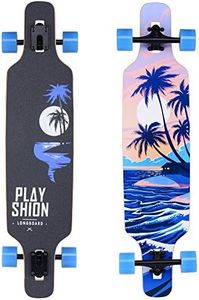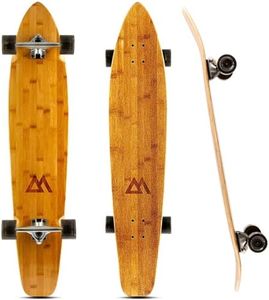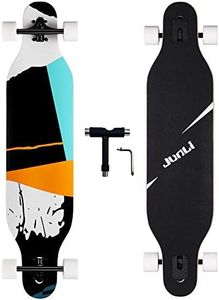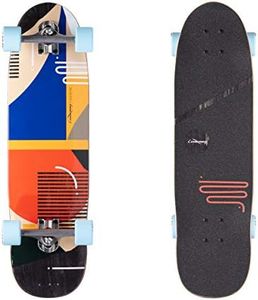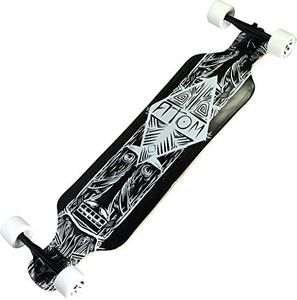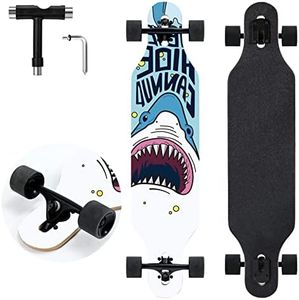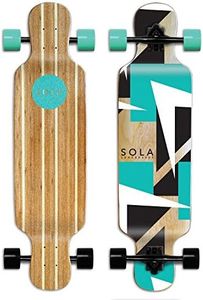We Use CookiesWe use cookies to enhance the security, performance,
functionality and for analytical and promotional activities. By continuing to browse this site you
are agreeing to our privacy policy
10 Best Cruiser Longboards
From leading brands and best sellers available on the web.Buying Guide for the Best Cruiser Longboards
Choosing the right cruiser-longboard comes down to understanding how you plan to use it and what features will suit your style and environment. Cruiser-longboards are great for everyday commuting, relaxed rides around town, and easy carving. To pick the best fit, it's helpful to know a little about the key aspects of a board—these specs will influence how it feels, how stable it is, and how easy it is to manoeuvre. Before making a purchase, consider where and how you’ll be riding, as this will shape which features matter most for you.Deck LengthDeck length is the measurement from the nose to the tail of the board. A longer deck, often over 38 inches, offers more stability and smoother rides, making it great for longer cruises or beginners. Shorter decks, closer to 32 inches, are more agile and easier to carry, helpful if you’re navigating crowded areas or want portability. Your height and preference for stability versus manoeuvrability should guide your choice—a taller rider or someone seeking smooth, stable rides usually benefits from a longer board, while someone needing nimbleness or easy storage might prefer a shorter one.
Deck ShapeThe shape of the deck affects how comfortable and responsive the board feels. Flat boards are simple, easy to balance, and suitable for casual cruising. Boards with concave (curved edges) provide increased grip for your feet, making it easier to stay stable and control the board when turning or carving. Kicktails, which are raised ends on one or both sides, help with tricks, quick turns, or navigating sidewalks. If you just want a laidback cruise, a flat or slightly concave deck works well, but if you want versatility or more control, look for boards with noticeable concave or kicktails.
Wheel SizeWheel size is measured in millimetres, with cruiser-longboard wheels usually ranging from about 60mm to 75mm. Larger wheels (70mm and above) roll over cracks or rough pavement more smoothly and maintain speed better, making them ideal for distance or uneven surfaces. Smaller wheels (60-69mm) accelerate quickly and are a bit lighter, suitable for city riding where sharp turns or frequent stops are common. If your main goal is smooth rides over varying terrain, go larger, but if you'll stick mostly to smoother sidewalks or want quick starts, a medium or smaller wheel may suit you better.
Wheel Durometer (Hardness)Durometer rates how hard or soft the wheels are, usually on a scale marked with 'A.' Softer wheels (around 78A-83A) grip the ground better, absorb bumps, and give a smoother, quieter ride—ideal for cruising around town or navigating rough roads. Harder wheels (over 85A) slide easier and feel quicker on very smooth surfaces, but may feel rough on city pavements. Most cruiser riders prefer softer wheels for comfort and traction, so opt for wheels on the softer side unless you plan to ride mainly on smooth, clean streets.
Truck Type and WidthTrucks are the metal parts connecting the deck to the wheels, allowing the board to turn. Wider trucks (matching the width of the deck) offer more stability, important for beginners or anyone riding at higher speeds. Reverse kingpin trucks tend to be more responsive and common for cruiser-longboards, making turns easier and more controlled. Consider your board width—the trucks should be about as wide as the deck for balance—and choose reverse kingpins for the smoothest, easiest carving and cruising experience.
Deck MaterialMost cruiser-longboards use wood, often maple or bamboo, sometimes with a composite layer. Maple boards are stiffer and durable, suitable for those who want a longer-lasting, responsive ride. Bamboo is lighter, has more 'flex,' and can absorb small vibrations, making rides smoother but a bit springier. If you want a stable, firm ride, go for maple, but if you crave something lighter and with a gentler feel underfoot, bamboo or a bamboo mix might be your ideal pick.
